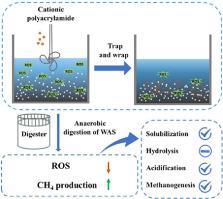Water Research ( IF 11.4 ) Pub Date : 2021-09-09 , DOI: 10.1016/j.watres.2021.117651 Baowei Zhang 1 , Xiang Tang 1 , Changzheng Fan 1 , Wanle Hao 1 , Yilin Zhao 1 , Yanjing Zeng 1

|
The enrichment of zinc oxide nanoparticles (ZnO NPs) in waste activated sludge (WAS) has raised concerns about their potential impact on anaerobic digestion of WAS. To date, there is no information regarding how to attenuate the negative effects of ZnO NPs on WAS anaerobic digestion. In this study, it was found that the appropriate amount of cationic polyacrylamide (cPAM) could mitigate the toxicity of ZnO NPs. During short-term exposure, the supplement of 4.0 mg cPAM/g TSS significantly restored biochemical methane potential from 28.6% inhibition to 9.3% inhibition compared with the control digester (P < 0.01). The spiked cPAM promoted the solubilization and acidification stages by weakening the contact between ZnO NPs and anaerobes in anaerobic digestion process, thus providing abundant substance for sequent bio-utilization. In the long-term semi-continues operated reactor, the continuous replacement of cPAM (at 4.0 mg/g TSS) significantly strengthened the recovery of VS destruction rate (20.3% to 26.4%, P < 0.01) and the daily yield of methane (93.5 mL/d to 124.2 mL/d, P < 0.01). Consistent with the restored performance, the application of cPAM increased the total microbial communities and the relative abundances of dominant acidogens and methanogens. Further explorations showed decreased toxicity of ZnO NPs primarily attributed to the decline of reactive oxygen species (ROS) induced by ZnO NPs.
中文翻译:

阳离子聚丙烯酰胺通过减少活性氧诱导的活性氧来减轻纳米氧化锌对废弃活性污泥厌氧消化的抑制作用
废活性污泥 (WAS) 中氧化锌纳米颗粒 (ZnO NPs) 的富集引起了人们对其对 WAS 厌氧消化的潜在影响的担忧。迄今为止,还没有关于如何减弱 ZnO NPs 对 WAS 厌氧消化的负面影响的信息。在这项研究中,发现适量的阳离子聚丙烯酰胺(cPAM)可以减轻 ZnO NPs 的毒性。在短期暴露期间,与对照消化器相比,4.0 mg cPAM/g TSS 的补充显着恢复了生化甲烷潜力,从 28.6% 抑制到 9.3%(P < 0.01)。掺入的 cPAM 通过减弱厌氧消化过程中 ZnO NPs 与厌氧菌之间的接触来促进增溶和酸化阶段,从而为后续的生物利用提供丰富的物质。在长期半连续操作的反应器中,连续置换cPAM(4.0 mg/g TSS)显着增强了VS破坏率的回收率(20.3%~26.4%,P < 0.01)和甲烷日产率( 93.5 mL/d 至 124.2 mL/d,P < 0.01)。与恢复的性能一致,cPAM 的应用增加了总微生物群落以及主要产酸菌和产甲烷菌的相对丰度。进一步的研究表明,ZnO NPs 的毒性降低,主要归因于 ZnO NPs 诱导的活性氧 (ROS) 的下降。











































 京公网安备 11010802027423号
京公网安备 11010802027423号